-
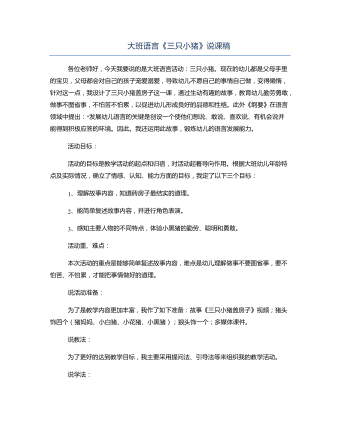
大班语言《三只小猪》说课稿
各位老师好,今天我要说的是大班语言活动:三只小猪。现在的幼儿都是父母手里的宝贝,父母都会对自己的孩子宠爱溺爱,导致幼儿不愿自己的事情自己做,变得懒惰,针对这一点,我设计了三只小猪盖房子这一课,通过生动有趣的故事,教育幼儿勤劳勇敢,做事不图省事,不怕苦不怕累,以促进幼儿形成良好的品德和性格。此外《纲要》在语言领域中提出:"发展幼儿语言的关键是创设一个使他们想说、敢说、喜欢说、有机会说并能得到积极应答的环境。因此。我还运用此故事,锻炼幼儿的语言发展能力。活动目标:活动的目标是教学活动的起点和归宿,对活动起着导向作用。根据大班幼儿年龄特点及实际情况,确立了情感、认知、能力方面的目标,我定了以下三个目标:1、理解故事内容,知道砖房子最结实的道理。2、能简单复述故事内容,并进行角色表演。3、感知主要人物的不同特点,体验小黑猪的勤劳、聪明和勇敢。
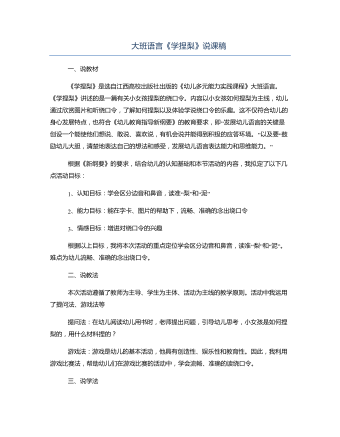
大班语言《学捏梨》说课稿
《学捏梨》是选自江西高校出版社出版的《幼儿多元能力实践课程》大班语言。《学捏梨》讲述的是一篇有关小女孩捏梨的绕口令。内容以小女孩如何捏梨为主线,幼儿通过欣赏图片和听绕口令,了解如何捏梨以及体验学说绕口令的乐趣。这不仅符合幼儿的身心发展特点,也符合《幼儿教育指导新纲要》的教育要求,即“发展幼儿语言的关键是创设一个能使他们想说、敢说、喜欢说,有机会说并能得到积极的应答环境。”以及要“鼓励幼儿大胆,清楚地表达自己的想法和感受,发展幼儿语言表达能力和思维能力。”根据《新纲要》的要求,结合幼儿的认知基础和本节活动的内容,我拟定了以下几点活动目标:1、认知目标:学会区分边音和鼻音,读准“梨”和“泥”2、能力目标:能在字卡、图片的帮助下,流畅、准确的念出绕口令3、情感目标:增进对绕口令的兴趣根据以上目标,我将本次活动的重点定位学会区分边音和鼻音,读准“梨”和“泥”。难点为幼儿流畅、准确的念出绕口令。
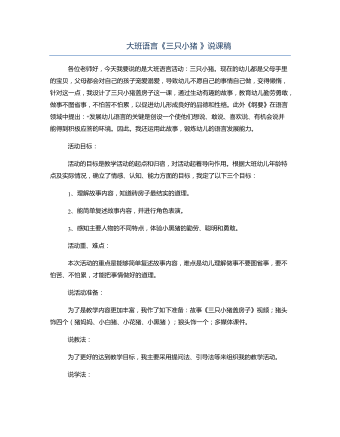
大班语言《三只小猪 》说课稿
各位老师好,今天我要说的是大班语言活动:三只小猪。现在的幼儿都是父母手里的宝贝,父母都会对自己的孩子宠爱溺爱,导致幼儿不愿自己的事情自己做,变得懒惰,针对这一点,我设计了三只小猪盖房子这一课,通过生动有趣的故事,教育幼儿勤劳勇敢,做事不图省事,不怕苦不怕累,以促进幼儿形成良好的品德和性格。此外《纲要》在语言领域中提出:“发展幼儿语言的关键是创设一个使他们想说、敢说、喜欢说、有机会说并能得到积极应答的环境。因此。我还运用此故事,锻炼幼儿的语言发展能力。活动目标:活动的目标是教学活动的起点和归宿,对活动起着导向作用。根据大班幼儿年龄特点及实际情况,确立了情感、认知、能力方面的目标,我定了以下三个目标:1、理解故事内容,知道砖房子最结实的道理。2、能简单复述故事内容,并进行角色表演。3、感知主要人物的不同特点,体验小黑猪的勤劳、聪明和勇敢。
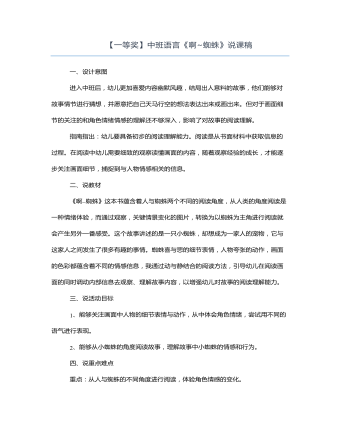
中班语言《啊~蜘蛛》说课稿
二、说教材《啊~蜘蛛》这本书蕴含着人与蜘蛛两个不同的阅读角度,从人类的角度阅读是一种情绪体验,而通过观察,关键情景变化的图片,转换为以蜘蛛为主角进行阅读就会产生另外一番感受。这个故事讲述的是一只小蜘蛛,却想成为一家人的宠物,它与这家人之间发生了很多有趣的事情。蜘蛛喜与悲的细节表情,人物夸张的动作,画面的色彩都蕴含着不同的情感信息,我通过动与静结合的阅读方法,引导幼儿在阅读画面的同时调动内部信息去观察、理解故事内容,以增强幼儿对故事的阅读理解能力。三、说活动目标1、能够关注画面中人物的细节表情与动作,从中体会角色情绪,尝试用不同的语气进行表现。2、能够从小蜘蛛的角度阅读故事,理解故事中小蜘蛛的情感和行为。四、说重点难点重点:从人与蜘蛛的不同角度进行阅读,体验角色情感的变化。难点:能够理解小蜘蛛的感受,从小蜘蛛的角度进行表达。
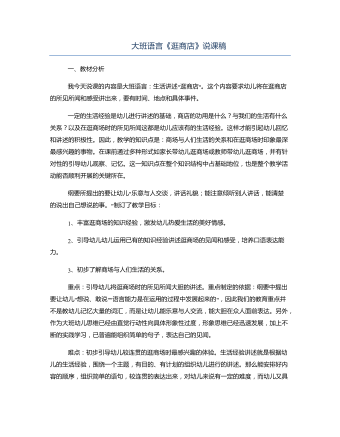
大班语言《逛商店》说课稿
纲要所提出的要让幼儿"乐意与人交谈,讲话礼貌;能注意倾听别人讲话,能清楚的说出自己想说的事。"制订了教学目标:1、丰富逛商场的知识经验,激发幼儿热爱生活的美好情感。2、引导幼儿幼儿运用已有的知识经验讲述逛商场的见闻和感受,培养口语表达能力。3、初步了解商场与人们生活的关系。重点:引导幼儿将逛商场时的所见所闻大胆的讲述。重点制定的依据:纲要中提出要让幼儿"想说、敢说""语言能力是在运用的过程中发展起来的",因此我们的教育重点并不是教幼儿记忆大量的词汇,而是让幼儿能乐意与人交流,能大胆在众人面前表达。另外,作为大班幼儿思维已经由直觉行动性向具体形象性过度,形象思维已经迅速发展,加上不断的实践学习,已普遍能组织简单的句子,表达自己的见闻。难点:初步引导幼儿较连贯的逛商场时最感兴趣的体验。生活经验讲述就是根据幼儿的生活经验,围绕一个主题,有目的、有计划的组织幼儿进行的讲述。那么能安排好内容的顺序,组织简单的语句,较连贯的表达出来,对幼儿来说有一定的难度,而幼儿又具有善于挑战的心理,这就象跳一跳就能够得到的果实,因此经过一定的努力也可以完成。因此这是本次教学活动的难点。二、教学方法根据教材的内容和分析主要运用了示范模仿法和启发联想法。第一种方法示范模仿法,幼儿天生具有良好的模仿性,任何事物幼儿都想亲自去模仿,语言活动中示范模仿法也是十分重要。幼儿在模仿中学习语音、语法,学习运用语言。在这里我不止单纯运用教师的示范,更重要的是幼儿的示范。因为作为身边的小伙伴的示范更能让幼儿所能接受。借助幼儿和老师的讲述开阔幼儿的思路,让幼儿在模仿的基础上有所发展。
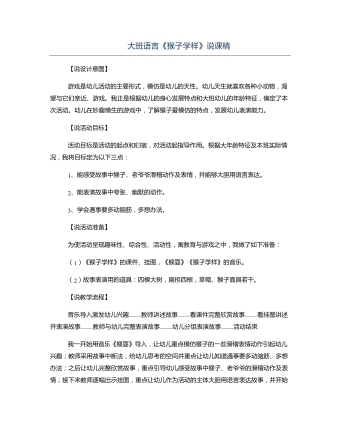
大班语言《猴子学样》说课稿
【说活动目标】活动目标是活动的起点和归宿,对活动起指导作用。根据大年龄特征及本班实际情况,我将目标定为以下三点:1、能感受故事中猴子、老爷爷滑稽动作及表情,并能够大胆用语言表达。2、能表演故事中夸张、幽默的动作。3、学会遇事要多动脑筋,多想办法。【说活动准备】为使活动呈现趣味性、综合性、活动性,寓教育与游戏之中,我做了如下准备:(1)《猴子学样》的课件、挂图,《猴耍》《猴子学样》的音乐。(2)故事表演用的道具:四棵大树,扁担四根,草帽、猴子面具若干。【说教学流程】音乐导入激发幼儿兴趣——教师讲述故事——看课件完整欣赏故事——看挂图讲述并表演故事——教师与幼儿完整表演故事——幼儿分组表演故事——活动结束我一开始用音乐《猴耍》导入,让幼儿重点模仿猴子的一些滑稽表情动作引起幼儿兴趣;教师采用故事中断法,给幼儿思考的空间并重点让幼儿知道遇事要多动脑筋、多想办法;之后让幼儿完整欣赏故事,重点引导幼儿感受故事中猴子、老爷爷的滑稽动作及表情;接下来教师逐幅出示挂图,重点让幼儿作为活动的主体大胆用语言表达故事,并开始尝试表演;教师简短小结后与幼儿共同表演,提升幼儿表演的欲望;幼儿分组表演,人人参与活动;幼儿表演结束后,教师建议将此节目定为六一节目之一进行排练。【说活动延伸】我将在班内表演区投放道具进行表演,作为活动延伸。对于本次活动,我简单说以上几点,当然整个活动下来,肯定还有很多不足之处,请各位领导及老师多提宝贵意见,谢谢大家!活动方案:【活动目标】1、能感受故事中猴子、老爷爷滑稽动作及表情,并能够大胆用语言表达。2、能表演故事中夸张、幽默的动作。3、学会遇事要多动脑筋,多想办法。

大班语言《漂流屋》说课稿
而我选择的《漂流屋》这个故事中一开头就描写了青蛙看到一座神奇的小屋子,调动了幼儿的兴趣“房子是谁的呢”?接着描写青蛙并没有想把它占为己有,而是去寻找屋子的主人,但没有找到主人,他就想到了请螃蟹和自己一起分享这座房子,并邀请了小鸟和乌龟来跟他们一起玩。最后,故事又承前启后地回到了开头的疑问:漂流屋飘到了它的小主人跟前,小兄妹并不想将自己制作的小屋子留着自己玩,而是希望它找到自己的主人。该故事虽然篇幅不长,人物对话简洁明了,但有趣的故事情节能吸引幼儿的注意。我们不难发现,故事的主题就是-----分享快乐。那故事中又是如何突破这个重点的呢:这则故事中再三描写了青蛙看到房子不占为己有的无私精神,后又描写了青蛙与小动物们一同分享快乐,继而描写了小兄妹乐于帮助别人。步步深入主题,而又在小青蛙与同伴分享住在漂流屋的快乐达到高潮。故事鲜明突出的人物形象,使幼儿受到很好的教育,生动浅显的语言,又便于幼儿理解、记忆和模仿。(二)幼儿情况分析大班幼儿的认识水平在不断提高,具体形象思维又占优势,因此,他们对文学作品,特别是童话故事较感兴趣,也能接受和理解内容较丰富、表现手法较复杂的故事,并具有一定的倾听和语言表达能力。上学期,我们以班级主题《童话谷》为切入口,发展幼儿的语言表达能力。我班的幼儿也积累了不少的童话故事知识、童话作家知识和丰富的词汇,培养了他们活泼大方、富有观察力、好奇心,探究欲望强,有丰富的想象力,并喜欢把自己对故事的理解通过各种形式表现出来。但是,由于幼儿成长环境的影响,幼儿经常出现自私、以自我为中心的现象,导致这些行为成为幼儿交往中的障碍。而故事是运用儿童文学作品向幼儿进行教育的一种重要形式。基于以上两点分析,我选择了故事主题明确、情节简单有趣,形象鲜明突出、语言生动浅显而富有教育意义的故事《漂流屋》。二、目标确定发展语言的关键是创设能使幼儿想说、敢说、喜欢说、有机会说并能得到积极应答的环境,同时幼儿语言的发展与其情感、经验、思维、社会交往能力等其他方面的发展密切相关。因此,根据纲要中语言领域的目标和知道要点提示以及本班幼儿的实际情况,我将本次活动的目标定位于:1、理解故事内容,抓住故事中心,有感情地讲述自己的看法或评价别人的发言;2、感受作品中比喻手法的运用,发展幼儿想象力。3、通过活动,体验与同伴分享带来的快乐。这三个目标中蕴涵了语言能力的培养、知识经验的获得和情感方面的培养,体现了目标的综合性和层次性。我们将本次活动的重点放在“体验与同伴分享带来的快乐”,从第一、第四环节的逐步深入,到最后互换礼物的情感体验,将知识进行迁移,将重点逐渐攻破。当然,培养幼儿懂得分享是需要一个漫长的累积过程的,因此,本次活动是先让幼儿获得情感体验,是一个累积良好体验的好机会,对幼儿有一定的教育意义。活动将难点定在“抓住故事中心,有感情地讲述自己的看法或评价别人的发言”从以下几点来突破:1、问题设计富有启发性,如:如果是你,你会怎么做?你觉得他这样做好吗?你有不同的看法吗?;2、集体与个别讨论、回答相结合。活动准备
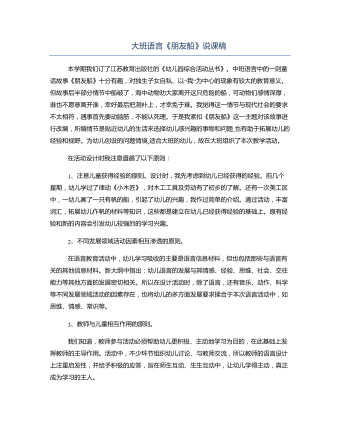
大班语言《朋友船》说课稿
在活动设计时我注意遵循了以下原则:1、注意儿童获得经验的原则。设计时,我先考虑到幼儿已经获得的经验。前几个星期,幼儿学过了律动《小木匠》,对木工工具及劳动有了初步的了解。还有一次美工区中,一幼儿画了一只有帆的船,引起了幼儿的兴趣,我作过简单的介绍。通过活动,丰富词汇,拓展幼儿作帆的材料等知识,这些都是建立在幼儿已经获得经验的基础上。原有经验和新的内容会引发幼儿较强烈的学习兴趣。2、不同发展领域活动因素相互渗透的原则。在语言教育活动中,幼儿学习吸收的主要是语言信息材料,但也包括那些与语言有关的其他信息材料。新大纲中指出:幼儿语言的发展与其情感、经验、思维、社会、交往能力等其他方面的发展密切相关。所以在设计活动时,除了语言,还有音乐、动作、科学等不同发展领域活动的因素存在,也将幼儿的多方面发展要求揉合于本次语言活动中,如思维、情感、常识等。3、教师与儿童相互作用的原则。我们知道,教师参与活动必须帮助幼儿更积极、主动地学习为目的,在此基础上发挥教师的主导作用。活动中,不少环节组织幼儿讨论、与教师交流,所以教师的语言设计上注重启发性,并给予积极的应答,旨在师生互动、生生互动中,让幼儿学得主动,真正成为学习的主人。根据大班上学期幼儿的发展制订了如下二条发展目标:1、通过创设丰富的教学情境,学会在已有经验的基础上大胆表达自己的见解和想法,发展思维能力。2、体验团结协作,战胜困难所带来的快乐。为了使幼儿身临其境,主动观察画面内容,切身体会到故事中角色的情感、心理,激发幼儿的想象力、创造力,我和其他老师一起设计制作了多媒体课件,使造船、上船、海上遇险等呈动态化,更加迎合幼儿具体形象思维的特点。基于以上的目标与设计原则,我精心设计本次活动的过程。
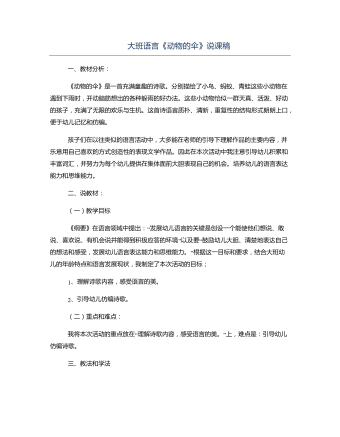
大班语言《动物的伞》说课稿
二、说教材:(一)教学目标《纲要》在语言领域中提出:“发展幼儿语言的关键是创设一个能使他们想说、敢说、喜欢说、有机会说并能得到积极应答的环境”以及要“鼓励幼儿大胆、清楚地表达自己的想法和感受,发展幼儿语言表达能力和思维能力。”根据这一目标和要求,结合大班幼儿的年龄特点和语言发展现状,我制定了本次活动的目标;1、理解诗歌内容,感受语言的美。2、引导幼儿仿编诗歌。(二)重点和难点:我将本次活动的重点放在“理解诗歌内容,感受语言的美。”上,难点是:引导幼儿仿编诗歌。三、教法和学法整个活动我遵循由浅入深的教学原则,让幼儿在听听、想想、说说、玩玩的轻松气氛中学习。其中,我还运用了课件演示法、启发提问法、游戏法等教学方法。四、教学过程与方式:这堂课我共安排了四个环节:第一环节我用伞舞的形式导入新课,激发幼儿的学习兴趣。(演示伞舞)欣赏完后,我提出问题“这是什么?它是做什么用的?”对于这种生活经验比较强的问题,我可以请一些语言表达能力较弱的幼儿来回答,并及时加以表扬和肯定。第二环节我安排的是学习诗歌。在这一环节中我设计了三个环环相扣的问题:第一的问题是“老师带你们到一个美丽的森林去玩,看看那里发生了什么故事”,通过展示课件,把幼儿带入诗的意境中。这个故事把幼儿的听觉与视觉巧妙的融合在一起,有一种身临其境之感。瞧,这美丽的画面,动听的雨声,多美妙啊!
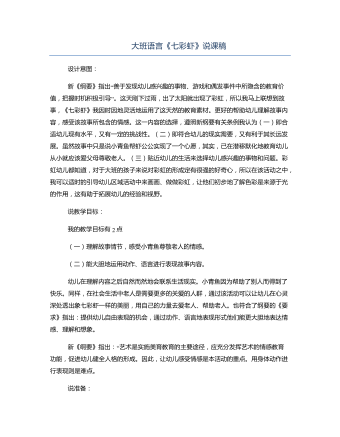
大班语言《七彩虾》说课稿
说教学目标:我的教学目标有2点(一)理解故事情节,感受小青鱼尊敬老人的情感。(二)能大胆地运用动作、语言进行表现故事内容。幼儿在理解内容之后自然而然地会联系生活现实。小青鱼因为帮助了别人而得到了快乐。同样,在社会生活中老人是需要更多的关爱的人群,通过该活动可以让幼儿在心灵深处透出象七彩虾一样的美丽,用自己的力量去爱老人、帮助老人。也符合了纲要的《要求》指出:提供幼儿自由表现的机会,通过动作、语言地表现形式他们能更大胆地表达情感、理解和想象。新《纲要》指出:“艺术是实施美育教育的主要途径,应充分发挥艺术的情感教育功能,促进幼儿健全人格的形成。因此,让幼儿感受情感是本活动的重点。用身体动作进行表现则是难点。

人教版高中英语必修3Canada-the true north说课稿4篇
Good afternoon, teachers, It’s my great pleasure to be here sharing my lesson with you.The content of my lesson is Senior English Book 3 Unit 5 Canada —— “The true North”.I’ll be ready to begin this lesson from five parts. Analysis of the teaching material,the teaching methods,the studying methods, the teaching procedure,and Blackboard design.First, let me talk about the teaching material.Part 1 Teaching Material:This unit is about the introduction of Canada. By studying of this unit,we’ll enable the students to learn the geography, population, main cities, and natural beauty, natural resources of Canada. Through the training of the unit, it also requires students to learn some Language skills such as the expressions of position and emotions.So it plays an important part in the English teaching in this book.After studying the teaching material and analyzing the rule of children’s growing of mind,I think the teaching aims are the followings:1.Knowledge objects:(1) make the students learn some new words and phrases(2) make the students understand the content of the lesson.2.Ability objects:(1)To develop the Ss’ abilities of listening, speaking, reading and writing. Especially reading and speaking ability.(2) learn to talk about the characters of Canada in English(3)To train the Ss’ ability of working in pairs.3.Emotion objects:(1)Enable students to understand the characters of Canada..(2)Stimulate Ss to work hard to make China stronger.Part 2 Teaching Methods:I think helping students learn to master new words and phrases and improve the students’ reading and speaking ability is import and the difficult.According to the analysis of the teaching material and the import points and the difficult points,I will use the following teaching methods : question-guiding approach; fast-reading and careful reading; multi-media teaching methods; discussion

人教版高中英语必修3The million pound bank note说课稿3篇
在接下来的细读环节,我套用了高考对阅读理解的考查方式设置了5个问题,分别为三个推理判断题,一个细节题和一个主旨大意题。学生需要对文章的内容进行分析、归纳、推理、猜测等高级思维活动才能做出正确的回答。【设计意图】这一过程是对学生进行细读的训练,培养学生获取特定信息和挖掘文章深层次信息的能力。第三环节:Intensive-reading (精读) 15′第三个环节精读,既是最重要的环节,也是突破本课重难点的关键。首先,让学生思考剧本中人物看到百万英镑前后的态度发生了怎样的变化。其次,让学生仔细阅读文章,找出可以表现人物态度变化的具体的语言和动作。最后,让学生总结人物的态度发生变化的根本原因是什么,从而引出Money Talks, 供学生思考。【设计意图】通过一系列的活动培养学生学习从人物的语言和动作探究人物的心理,使学生进一步体会戏剧语言的魅力,从而对文章背后所反映的社会问题进行思考,也为下一步的讨论环节做好铺垫。
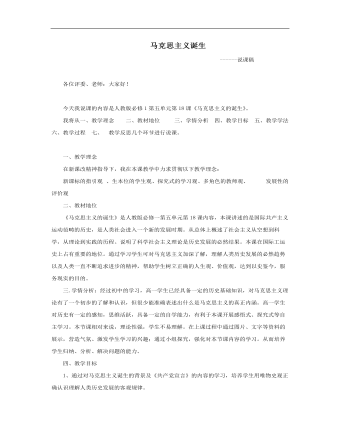
高中历史人教版必修一《马克思主义的诞生》说课稿
一、教学理念在新课改精神指导下,我在本课教学中力求贯彻以下教学理念:新课标的指引观 、生本位的学生观、探究式的学习观、多角色的教师观、 发展性的评价观二、教材地位《马克思主义的诞生》是人教版必修一第五单元第18课内容,本课讲述的是国际共产主义运动范畴的历史,是人类社会进入一个新的发展时期。从总体上概述了社会主义从空想到科学,从理论到实践的历程。说明了科学社会主义理论是历史发展的必然结果。本课在国际工运史上占有重要的地位。通过学习学生可对马克思主义加深了解,理解人类历史发展的必然趋势以及人类一直不断追求进步的精神,帮助学生树立正确的人生观、价值观,达到以史鉴今,服务现实的目的。

人教版高中英语必修1Journey Down the Mekong说课稿
2. let the Ss complete the forms paragraph by paragraph. Purpose here is to help Ss to get the habit of reading a passage as a whole, and pay attention to the organization of the text, as a result the Ss will fully understand the whole passage.3. ask Ss to retell the passage with the help of the key words in the form.Since the Ss in the class are in different levels, so I let them to fill in the blank to understand the meaning of the words and phrases better. ( That’s all for the while-reading. Now let’s move to the fifth step.)Step V: Post-reading (10mins) ---DiscussionIn this part students are asked to discuss in groups and list Wang Kun’s and Wang Wei’s attitudes about the trip. After that, Ss are encouraged to express their attitudes with the whole class. Collect their answers and don’t forget to praise them even if their answers may not be perfect.In this activity, discussion provides a vivid and active learning environment for Ss to communicate in English with newly learned language items. (Finally it comes to the homework.)StepⅥ: Homework (1min)1. Ss are required to read the text again after class and figure out the meaning of some complex sentences.2. Do the exercises on P19; This can help Ss to consolidate what they’ve learnt and make preparation for the next lessonPart4. Blackboard design.(说板书设计)On the top, there is the title of this lesson. On the left, there are main ideas for each paragraph. On the right, there are some new words and expressions.Unit 3 Travel journalJourney down the MekongMain idea of each para.:Para1: deciding to take a great bike trip along the Mekong river.Para2: Different attitudes between Wang kun and Wang wei.

人教版高中英语必修1Anne's best friend说课稿
Step 7 Language points 1.Vocabulary (1) go through (2) set down (3) a series of (4) on purpose (5) in order to (6)at dusk (7)entirely (8)face to face 2.Important sentences (1)…I’ve grown so crazy about everything to do with nature. (2)There was a time when … (3)I stayed awake on purpose until … (4)It was the first time … that I’d seen the night … (5)It’s no pleasure looking through … Purpose: 1.Master the required vocabulary and sentence structures. 2.Use them freely. Step 8 Consolidation 1.Find out the topic sentences 2.Retell the text according to the topic sentences Purpose: I want to know if my students understand the text. Step 9 Discussion Imagine you have to go into hiding like Anne and her family, what would you miss most? Giveyour reasons. Purpose: Train Ss’ oral English ability. Step 10 Homework Write an article on Friends. Purpose: 1. Improve the Ss’ writing ability. 2 Train the Ss’ ability of self—teaching and looking up information by themselves. Part 5 Blackboard design(说板书设计)Unit 1 Friendship Reading Anne’s Best Friend 1.Main idea of each paragraph: Para. 1 Anne made her diary her best friend. Para .2 Anne wrote her feelings in her diary. Para .3 Anne missed nature. Para.4 Anne saw the night face to face Para.5 Anne wanted to experience nature outdoors. 2.Listening: Exx.1 P3 3.Discussion: Exx.3 P3 Purpose: 1.Make Ss familiar with the passage 2.Make the design inductive, instructive and artistic.

人教版高中英语必修1English around the world说课稿
(3)v. 给:提出;展现,显现present sb. with sth. ; present sth. to sb. 把. . 交给;颁发;授予present sth. (for sth. )/present sth. to sb. e. g. Om his birthday, his friends presented him a collection of stamps. 在他生日时,他的朋友们送给他一套邮票作为礼物。The sword was presented by the family to the museum. 这家人把宝剑捐赠给了博物馆。The committee will present the final report to Parliament in June. 委员会将在六月向议会提交最后的报告。You need to present yourself better. 你需要更善于展现自己。It is essential that we present a united front. 至关重要的是我们要表现得更加团结。Step 4 ConsolidationT:Now that we have got a general idea of these words and phrases. Lets make up some sentences using them to master them. Suggested sentences:1. Your duties include typing letters and answering the telephone. 2. It is one of the greatest roles that she has played. 3. A large number of people have applied for the job. 4. The number of the panda is declining. 5. I'11 go there, even if I have to walk. 6. He came up to me to ask for a light. 7. The novel is about a family who can't communicate with each other. 8. He based his plan on interests of most people. 9. Why doesn't he make use of his singing talent?Step 5 Summary and homeworkT:Today we dealt with several new words and phrases. After class I hope that youcan read them again and again to keep them in mind. That's all for today. You aredismissed.

人教版高中英语必修1Nelson Mandela--A Modern Hero说课稿
In this step, give students a few minutes to read the passage . While they are reading, I will write some key words of the text on the blackboard. Then ask students to retell the passage according to the key words.By retelling, students can improve their ability of language organization and have an overall understanding of the article.Step 4 Group discussionIn this step, students will be divided into groups of 4 to discussion the following question: What qualities make a great person?After their discussion, invite a few groups to make a report to the class.This group discussion can practice students’ oral English and cultivate their abilities of cooperation and communication.Step 5. HomeworkLet students write a short passage to introduce a great person he or she admires.The homework can consolidate the knowledge the students have learned and cultivate their writing ability. Part 6 Blackboard Design(板书设计)That’s all my teaching procedures. Finally, I’d like to say sth about part 6 blackboard design. On the top is the title. On the left, there will be some new words and expressions. In the middle of the blackboard, I will write some useful sentence structures so that the students can know clearly what they’ve learned and then try to master the knowledge.OK. That’s all for my presentation. Thank you for your attention.

人教版高中英语必修2Computers说课稿3篇
一. 教材分析1. 本单元的中心话题是“计算机(Computers)”,内容涉及计算机的发展历史,计算机的应用等。本节课是该单元的第一课时,我将Warming up, Pre-reading and Comprehending这四部分整合为一节精读课。其中。Reading部分是题为WHO AM I?的文章,以第一人称的拟人手法介绍了计算机发长演变的历史和计算机在各个领域的应用,其主旨是表达计算机的发展变化之快以及在生活中用途之广。而Warming up部分以图片的形式展现了计算机的发展历程;Pre-reading中的问题和排序分别是为了预测语篇的内容和测试学生对计算机历史了解的情况;Comprehending则通过各项练习训练学生的阅读技能,从而加深对文章的理解。可见这几部分是一个有机的整体。2. 教学目标:1) 语言目标:重点词汇及短语:abacus, calculate, calculator, PC, laptop, PDA, robot, analytical, technological, universal, mathematical, artificial, intelligent, network, explore, in common, as a result.重点句子:a. My real father was Alan Turing, who in 1963 wrote a book to describe how computers could be made to work, and build a “universal machine” to solve any mathematical problem.

人教版高中英语必修2Cultural Relics说课稿2篇
Ⅲ. Analysis of the teaching material:The topic of this unit is cultural relics. Students are quite interested in topics about different cultures around the world. This is the second period of the whole unit. As a reading class, the passage mainly talks about the history of the amber room (how it was made, sent as a gift, lost and rebuilt).According to the new national curriculum, when teaching reading, much emphasis should be put on training the students’ reading skills.Ⅳ. Teaching objectives1. Language objectives:1) Students are required to master the key words and phrases occurred in the passage (e.g. amazing, decorate, belong, in return, less than etc.)2) Students are required to learn the attributive clause and acquire the sentence pattern.2. 1) Students are required to describe a certain thing by using the new sentence patterns.2) Students are required to master two kinds of reading skills—skimming and scanning, and learn to use them in their daily reading.3. 1) Students are required to know the history of the amber room.2) Students are required to appreciate cultural relics and understand the importance of protecting them.Ⅴ. Teaching important and difficult points1) the new words, phrases, and sentence pattern in the course of reading.2) Teaching difficult point: Help the students master two kinds of reading skills—skimmingand scanning and learn to apply them in daily use.Ⅵ. Teaching methods:Task-based method & Top-down model Ⅶ. Teaching aids: PPT, pictures, blackboard Ⅷ. Teaching procedure:

人教版高中英语必修3Astronomy the science of the stars说课稿3篇
Step 2 Pre-listeningAfter students finish their discussion, I will show a picture of Newton and ask them: Who is him? What is he famous for? Could you find out some words to describe him? Maybe students will answer that he is genius for his finding of theGravitation, making a great contribution to the progress of human being. At that time I will show another two pictures of Einstein and Hawking, letting students guess who they are and write down their idea about the Gravitation. For I have arranged them to search more information about the gravity before this class, Students have beenfamiliar with the topic and will not be afraid about this abstract conception, which is helpful for their listening.Step 3 While-listeningIn this step, students will be required to listen the material for three times. The first and listening is extensive listening and the second and third listening is intensive listening. In the first time, They are required to listen a material including Part 1 and Part 2 and choose the best summary of the listening text. After they choose the right answer, They also need work in group to explain what is wrong with the others. Then I will make a conclusion that we should pay attention to the first paragraph and last paragraph and some keys to get the main idea. By doing this, their capacity of generalization will have a great improvement.Before the second listening, I will ask students to scan the blank on the power point quickly and ask them to note down some key words .Then ask them to listen to the Part 1again and fill the first column of the chart. Maybe some students just show the ideas of these three scientists an still can’t catch their development of gravity. Therefore, I will ask them to listen to Part 2 again and fill in the rest. After finish the listening, I will give them ten minutes to discuss with their partner. I will also guidethem to improve their answers when they discuss with others.

